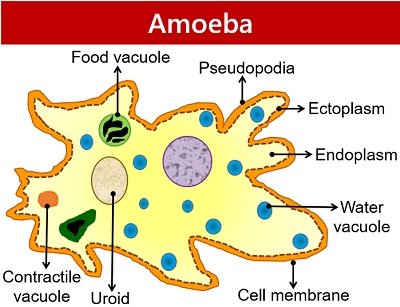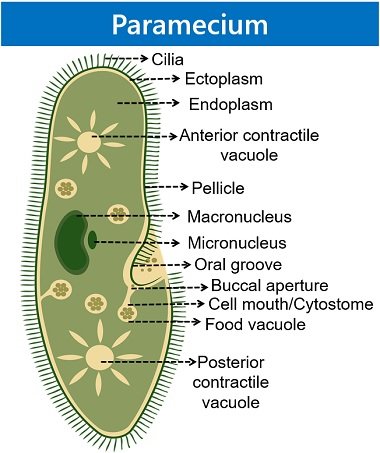The difference between amoeba and paramecium relies on locomotion. Amoeba moves and feeds with pseudopods or temporary extensions. Activation of microfilament polymerization propels the cell membrane, ensuing pseudopodia formation.
Paramecium moves through short hair-like cilia. Many tiny hair-like cilia are present throughout the pellicle. Its number varies from species to species.
Oral cilia surround the exterior of the oral groove and capture food materials. Body cilia encircle the body surface and help in the locomotion of the organism.
This post discusses key differences between amoeba and paramecium and the comparison chart. You can also learn the definition, nutrition mechanism and similarities between the two.
Content: Amoeba Vs Paramecium
Comparison Chart
| Properties | Amoeba | Paramecium |
|---|---|---|
| Meaning | Amoeba is a single-celled protist with irregular or asymmetrical shape | Paramecium is a single-celled protist that appears slipper-like |
| Phylum | Amoebozoa | Ciliophora |
| Class | Tubulinea | Ciliates |
| Family | Amoebidae | Parameciidae |
| Size | 250 to 750 microns | 50 to 300 µm |
| Habitats | Amoebae can be found in terrestrial as well as aquatic habitats | Mainly found in aquatic habitats |
| Cell membrane | Cell membrane or plasmalemma is devoid of the cell wall or outer membrane | A stiff pellicle surrounds the cell membrane |
| Pellicle | Absent | Thin, firm and flexible pellicle is present |
| Cell extensions | Amoebae have temporary extensions of the cytoplasm, i.e. pseudopodia | They carry a uniform layer of hair-like cilia outside the cell body |
| Trichocysts | Absent | Paramecia have Trichocysts as small spindle-shaped bags |
| Ectoplasm | Clear and gel-like | Firm, clear, thin and dense plasmagel |
| Endoplasm | Granular and comprises organelles | Voluminous and granular semifluid plasmasol |
| Nucleus | Amoebae have a single granular nucleus | They have macronucleus and micronucleus |
| Oral groove or Mouth pore | Absent | Present on the ventrolateral side and consists of large, oblique and shallow depression |
| Cytopyge or Cytoproct or Anal pore | Absent | Present vertically behind the cytostome |
| Contractile vacuoles | Amoebas have a single contractile vacuole | Paramecia have anterior and posterior contractile vacuoles on the dorsal side |
| Food vacuoles | These are formed by the endocytosis of the food material | These are formed by the budding of the gullet |
| Feeding | Feeds on single-celled algae and bacteria | Feeds on single-celled bacteria, algae, yeasts and unicellular plants |
| Ingestion | Ingests food by expanding pseudopodia around the food material | Ingests food by oral cilia into the oral groove |
| Egestion | Cell membrane ruptures to remove the undigested food from its body | Undigested food is expelled out through the anal pore |
| Reproduction | Reproduce asexually via binary fission | Reproduce asexually via binary fission and sexually via conjugation |
Definition of Amoeba
Amoebas are microscopic single-celled organisms belonging to the Kingdom Protista. Amoebas appear as jelly-like globules, which inhabit saltwater, freshwater and wet soils. But, some amoebas can live inside the guts of humans and animals as commensals or parasites.
Their cell body is irregular or asymmetrical due to the cell wall absence. Amoebas exhibit a unique crawling motion by expanding or contracting the pseudopodia. The amoeba structure has the following distinct regions that you can see in the diagram below.

- The cell membrane is irregular or asymmetrical.
- Pseudopods are the cell-membrane extensions that help in:
- Protoplasmic movement
- Food ingestion by the amoeba
- Ectoplasm is the outer gelatinous region.
- Endoplasm is the inner fluid region containing cell organelles.
- They lack a mouth and anal pores, unlike paramecium.
- Amoeba has a spherical granular nucleus containing the genetic material.
- Food vacuoles digest food.
- Contractile vacuoles throw excess water and waste outside the cell.
- Uroid is the bulb-like structure existing in some amoeba species. It is the region where the waste accumulates for some time.
- Water vacuoles contain watery fluids.
- Lysosomes are vesicles containing hydrolytic enzymes that break complex food into simpler forms.
Classification
- Domain: Eukaryota
- Kingdom: Protista
- Phylum: Amoebozoa
- Class: Tubulinea
- Order: Euamoebida
- Family: Amoebidae
- Genus: Amoeba
Nutrient Uptake in Amoeba
1. Ingestion: Amoeba propels through temporary cell extensions or pseudopodia in search of food. Activation of microfilament polymerization pushes the cell membrane outwards, ensuing pseudopodia formation.
Amoeba generally has tubular pseudopodia with rounded ends. They extend pseudopods around the food material. Later, amoebas engulf the whole food or organism through phagocytosis. Here, a vesicle forms around the food material called the food vacuole.
2. Digestion: A food vacuole carries the internalized food material by the amoeba. Then, lysosomes fuse with food vacuoles, releasing digestive enzymes inside the vacuole. It leads to the breakdown of complex food into digestible nutrients.
3. Absorption: Later, the amoeba cell absorbs nutrients obtained after the food enzymatic digestion. After absorption, the food vacuole remains with the undigested wastes. The cell store the absorbed food nutrients and use them later for energy synthesis.
4. Egestion: Here, the food vacuole with remaining wastes goes near the cell membrane. Later, it fuses with the cell membrane to release the undigested contents.

Definition of Paramecium
Paramecia are unicellular organisms that are part of the kingdom Protista. They have a slipper-like appearance with a size ranging from 50 to 300 um. Paramecium species are free-living and found in freshwater habitats. The paramecium structure has the following distinct regions that you can see in the diagram below.

- A pellicle is the stiff and thin outer covering of the cell membrane. It gives a definite shape to the organism.
- Cilia (tiny hair-like filaments) cover the body of paramecium. Based on functions, cilia are of two types:
- Body cilia help in the locomotion of the entire organism.
- Oral cilia drag the food into the oral groove.
- Ectoplasm is the thin firm region containing trichocysts.
- Endoplasm is the inner fluid region containing cell organelles.
- Paramecium comprises the distinct mouth and anal pores.
- Macronucleus appears ellipsoidal, and micronucleus appears spherical.
- The budding of the gullet forms food vacuoles.
- Contractile vacuoles help in excretion and osmoregulation by expelling wastes and excess water. These are present on the anterior and posterior ends.
Classification
- Domain: Eukaryota
- Kingdom: Protista
- Phylum: Protozoa
- Sub Phylum: Ciliophora
- Class: Ciliatea
- Order: Hymenostomatida
- Genus: Paramecium
Nutrient Uptake in Paramecium
1. Ingestion: Paramecium swallows food by the oral cilia. Then, the captured food goes into the gullet through a mouth pore. Paramecium ingests the food with some surrounding water. As a result, a food vesicle forms.
2. Digestion: Parameciums have intracellular digestion. Food digestion occurs inside the food vacuole. The digestive enzymes released by the cytoplasm helps in breaking down the food.
3. Absorption: The cytoplasm absorbs the nutrients obtained after the enzymatic digestion. Later, the food vacuole shrinks after the absorption of desired nutrients. Then, paramecia store the absorbed food nutrients and use them later for energy synthesis.
5. Egestion: Paramecium expels the undigested food out of the body via the fusion of food vesicles with the cell membrane.
Key Differences Between Amoeba and Paramecium
- Amoeba is a single-celled protist with an irregular or asymmetrical shape. Paramecium is a single-celled protist that appears slipper-like.
- Cell membrane or plasmalemma of amoebas is irregular and devoid of the cell wall. In comparison, the cell membrane of paramecia comprises a thin, firm, flexible pellicle.
- Amoebae move through temporary extensions of the cytoplasm, i.e. pseudopodia. But, paramecia locomote through a uniform layer of hair-like cilia outside the pellicle.
- Paramecia have small spindle-shaped trichocysts in the ectoplasm, while amoebas lack trichocysts. Trichocysts lie perpendicular to the ectoplasm.
- Ectoplasm and endoplasm are regions found in the cytoplasm of amoeba and paramecium. Amoeba has a transparent gel-like ectoplasm. In contrast, paramecium consists of ectoplasm as a firm, clear, thin and dense plasma gel. Amoeba comprises granular endoplasm. In contrast, paramecium consists of endoplasm as a voluminous and granular semifluid plasmasol.
- Amoebae have a single granular nucleus. In contrast, paramecia have an ellipsoidal macronucleus and a small spherical micronucleus.
- Amoeba lacks mouth and anal pores. But, paramecia have cytostome or mouth pore on the ventrolateral side. There is a large, oblique and shallow depression from the cytostome. Also, they comprise cytoproct or anal pores behind the cytostome.
- The contractile vacuoles expel excess water. Amoebas have a single contractile vacuole. But, paramecia have anterior and posterior contractile vacuoles on the dorsal side.
- Food vacuoles encapsulate and break down food captured by the organism. Paramecium forms food vacuoles by the budding of the gullet. In contrast, an amoeba forms a food vacuole via phagocytosis.
- The cell membrane of amoebas ruptures, removing wastes outside the body. In comparison, paramecium expels the undigested food through the anal pore.
- Amoebas reproduce via binary fission. In contrast, paramecia can reproduce through binary fission or conjugation.
Similarities
- Both amoeba and paramecium belong to the kingdom “Protista” and phylum “Protozoa”.
- Amoebas and paramecia are microscopic single-celled eukaryotic organisms.
- Amoeba and paramecium have the holozoic (animal-like) mode of nutrition.
- Both are heterotrophs. They cannot photosynthesize food or depend upon other organisms for food.
- The cell cytoplasm of both contains outer ectoplasm and inner endoplasm.
- Amoeba and paramecium contain food vacuoles for the digestion of internalized food material.
- Both have contractile vacuoles for excretion and osmoregulation.
- Binary fission is the common mode of asexual reproduction that occurs in both.
Conclusion
Amoeba and Paramecium are the free-living protozoans belonging to the kingdom Protista. Yet, some species of amoeba behave like parasites, causing severe illness in humans. Both amoeba and paramecium play a pivotal role in the ecosystem.
They feed upon organisms like algae, bacteria and smaller organisms in the environment. Thus, they balance the population of such organisms in the ecosystem. Also, they are important from a research point of view.
